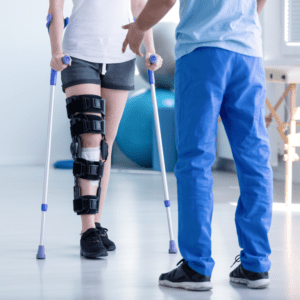

Depending on the part of the body that is affected and the injury being treated, different methods of immobilization may be required to help with the healing process.
- A plaster cast is made from gauze and plaster strips soaked in water, which are then wrapped around the injured body part. These casts harden in 24 to 48 hours.
- A synthetic cast is made from fiberglass or plastic strips, making it lighter than a plaster cast.
- A splint, which is also called a half cast, is made from slabs of plaster or fiberglass that are held in place with a bandage wrap. Splints are often used temporarily when swelling is present. They are usually replaced with a more permanent cast after the swelling goes down.
- A brace is made of hard plastic and can be removed by you or your child. A brace might be used to correct a genetic disorder, such as scoliosis, or prevent pain from a sports injury, often in the knee or elbow.
If your leg is immobilized, a walking aid may be necessary to help you get around without disturbing the injury. Some walking and mobility aids are used to keep weight off of injuries, while others are designed to provide assistance with balance or to reduce fatigue from walking.
- Canes have a lot of uses, but their primary purpose is to alleviate pain and help you be steadier on your feet. Canes are inadvisable if you have an injury that requires you to not put any weight or pressure on the affected foot or leg.
- Using crutches is best if you need to keep weight completely off of an injured foot or leg.
- Forearm Crutches are often used as an alternative to traditional crutches because they reduce pain in your armpits while using them. However, they place significant pressure on your forearms and place more weight on your hands than traditional crutches. They also don’t allow for hands-free mobility during recovery.
- Knee scooters are popular because they allow you to get from one place to another fairly smoothly. However, they don’t allow you to utilize staircases, they are not entirely hands-free, and moving across uneven terrain may be difficult.
- Hands-free crutches allow for full mobility and help keep weight off your leg. However, they are best used for injuries below the knee, as they require the knee to provide support for your leg.
Incorrectly using your walking device or choosing the wrong device can cause pain or can lead to further complications. Make sure your walking aid or mobility device is properly adjusted to your height and use the walking aid recommended by your doctor. If you’re unsure of how to use your walking aid, ask your doctor or Physical Therapist to teach you.
Need help getting mobile after an injury? Call the Vereen Center today.


